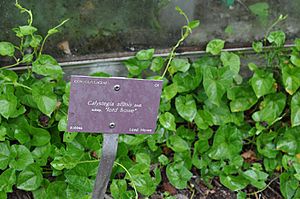Calystegia affinis facts for kids
Quick facts for kids Calystegia affinis |
|
|---|---|
 |
|
| Conservation status | |
| Scientific classification | |
| Genus: |
Calystegia
|
| Species: |
affinis
|
| Synonyms | |
|
Convolvulus affinis (Endl.) Maiden nom. illeg. Convolvulus marginatus (R.Br.) Spreng. nom. illeg. Calystegia marginata R.Br. (misapplication) |
|
The Calystegia affinis is a special type of climbing or creeping plant. It is also known as a vine. This plant belongs to the plant family called Convolvulaceae. It is found only on Lord Howe Island and Norfolk Island. These islands are in the Pacific Ocean. This plant is very rare. In 2003, there were only about 45 adult plants known. Most of them, about 40, were on Norfolk Island. This makes Calystegia affinis a critically endangered species. This means it is at a very high risk of disappearing forever.
What's in a Name? The Story of Calystegia affinis
The name of a plant often tells us something about it. The first part of the name, Calystegia, comes from ancient Greek words. "Kalux" means "cup" and "stegos" means "a covering". This name describes how the plant's special leaves, called bracteoles, cover its flower parts.
The second part of the name, affinis, is a Latin word. It means 'neighbouring' or 'closely related'. The scientist who named it, Stephan Endlicher, might have chosen this name because he thought it looked very similar to another plant, Calystegia marginata.
What Does Calystegia affinis Look Like?
Calystegia affinis is a plant with thin stems. It climbs by twisting its stems around other plants or objects. Its leaves are shaped like arrowheads. They are about 6 centimeters long and 5 centimeters wide. The leaves grow one after another along the stem.
The flowers of this plant are quite pretty. They grow one by one from where the leaves meet the stem. The flowers are pink and shaped like a funnel. They have five creamy white stripes running down them. Each flower has five petals and five sepals. The sepals are protected by large bracteoles.
After the flower, the plant produces a fruit. This fruit is a papery capsule. It splits open into four parts when it is ripe. Scientists believe this plant can make new plants in two ways. It can grow new plants from its own parts (clonally). It can also grow new plants from its seeds.
How Calystegia affinis Was Named and Classified
The plant Calystegia affinis was first officially described in 1833. This was done by a scientist named Stephan Endlicher. Later, in 1904, another scientist, Joseph Maiden, tried to rename it. He called it Convolvulus affinis. However, this new name is not considered correct by plant experts today.
Over time, scientists have learned more about this plant. They have refined its classification. This means they have made its scientific grouping more accurate. A scientist named P.S. Green helped to clarify its place in the plant world in 1994. This work was part of a big book called Flora of Australia.


